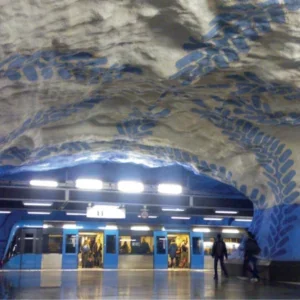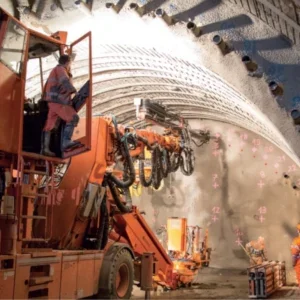In tunnelling projects, it is generally considered that 60%-70% of embodied carbon is contained in the concrete linings of shafts and tunnels (Allen, 2021). Concrete and steel sometimes make up more than 80% of embodied carbon on major tunnelling projects (Sauer, 2016; Wittke et al., 2022).
The majority of concrete is based on ordinary Portland cement (OPC). The increase in cement production contributes to the increase in the concentration of CO2 in the atmosphere (7% of CO2 emissions in 2021) due to the process of decarbonisation of limestone and the use of fossil fuels for cooking clinker (Grataloup Atlas, 2022).
As a result, the tunnelling industry is seeking ways to significantly reduce or eliminate the use of OPC.
Alternatives are sought for segmental linings, in situ linings and sprayed concrete.
The tunnelling industry is looking for innovative solution to meet structural and sustainable requirements, where the sustainability of a construction process or a resulting product can be objectively assessed using different approaches in scientific literature.
Moving to Sustainability Index
In 2017, the International Federation for Structural Concrete (fib) introduced a sustainability index (fib bulletin 83), which is assessed by using the MIVES method (Losada et al. 2006, San José and Josa, 2008, San José and Garrucho, 2010, de la Fuente et al. 2016a).
The MIVES method is a systems-based approach to multi-factor assessment that relates to infrastructure. It has the following steps:
- Define the problem to be solved and decisions required to be made
- Produce a basic diagram of the decision model with all the aspects for the assessment, in the form of a requirements tree that may include qualitative and quantitative variables
- Establish the required mathematical functions for conversion of the qualitative and quantitative variables into a set of variables, having the same units and scales
- Establish a system of relative weighting to be used in the assessment
- Define the design alternatives that could solve the identified problem
- Use the decision model to evaluate and assess the alternatives; and
- Select the most appropriate alternative
As prime sponsor of the International Tunnelling Association (ITA), Bekaert BP Underground Solutions fully supports the vision expressed by the organisation to lead the world in achieving sustainable use and development of tunnels and underground space, including efforts to promote low carbon linings and a new sustainability index for the industry.
FRC – doing more with less steel
Today, Bekaert’s innovation processes has become structured, covering the entire flow from idea generation to market launch.
Concrete and steel have always been complementary substances – concrete resists compression, while steel is resistant to tension. Concrete protects steel from corrosion so long as concrete is alkaline, and its cover thickness also protects and therefore delays potential softening of steel during a fire.
Concrete expands/contracts in the same manner during changes in temperature (i.e., same thermal expansion coefficient).
Bekaert has always been a pioneer in the field of steel fibre reinforcement. It was the first company to recognise the huge potential that this new technology could bring to the construction world, and, back in the 1970s, was granted a licence to market the steel fibre products.
In several of our factories, we have also implemented a production platform dedicated to the production of Dramix® steel fibres. Since 2010, all Dramix® production sites have earned ISO 14001 certification, and this is part of Bekaert bringing about a true revolution in steel fibre reinforcement for concrete (SFRC).
Those solutions are making steel fibres more resistant, safer, more durable and even more practical for use. But above all, Dramix® products are opening up possibilities for designs with concrete in tunnels. There is continuous effort to minimise environmental impact by integrating sustainability at all levels of the business.
Our Environmental Product Declaration (EPD) communicates the key environmental performance indicators of Dramix® over its lifetime, validated by an official independent third party (ITB) and it is being implemented already in One Click LCA’s tool
In recognition of Bekaert’s long-standing commitment in delivering profitable and sustainable solutions, its Dramix® steel fibre for low carbon concrete reinforcement is the company’s first solution to receive the Solar Impulse Foundation Label.
The Building Products team and other teams have been working on achieving this recognition for a long time as the Solar Impulse Foundation Label is granted to the solutions that show excellence in both business and sustainable benchmarks.
The use of fibre reinforced concrete (FRC) allows several advantages, compared with traditional steel mesh or steel bar reinforcement:
Can facilitate remote working from the face, and may remove the need for traditional reinforcement, to enhance the safety of the workers
- Provides crack control and a small enhancement of the concrete’s tensile properties
- Less prone to carbonation and chloride attack
- Reduction of cost and time saving
- Less material usage (through minimising the amount of steel and the concrete cover required)
One key technical requirement is to get hardening postcrack behaviour at section level. If fibres are used as the only reinforcement for the final lining, hardening postcrack behaviour at the section level (beam test) allows:
- Crack control (service limit state – SLS)
- Structural ductility (ultimate limit state – ULS )
Figure 1 shows a typical result of the beam tests considering 40kg of Dramix® 4D 80/60BGP type fibres with significant strength values. FL is peak force, fR1 and fR3 are the stresses related to CMODs equal to 0.5mm and 2.5mm, respectively. These values are the reference for final lining design performed according to the fib Model Code 2010 prescriptions.
The hooked ends ensure the desired fibre pull-out performance is obtained. The mechanism generates the renowned concrete ductility and post-crack strength.
The tensile strength of a steel fibre must increase in parallel with the strength of its anchorage. Only in this way can the fibre resist the forces acting upon it. Otherwise, it would snap, causing the concrete to become brittle. On the other hand, a stronger wire cannot be fully utilised with an ordinary anchor design. Therefore, the tensile strength of a fibre has to be perfectly aligned with its anchorage system and its diameter. A network effect superior to 10 000 lm/m3 is considered as a key factor to providing a consistent result and low variation.
Moving to low carbon FRC
Recent projects have demonstrated that structural ductility, durability and sustainability are going hand to hand. Adjustments in concrete are being discussed (Edvardsen – ‘The consultant’s view on service life design’) and there can be further reduction of concrete by replacing rebar with steel fibres in dosages that satisfy all the design requirements.
Advances achieved in durability performance are carried on from previous projects. Moreover, the advances in terms of durability are associated with a gain in terms of sustainability, but it is stressed that the advances in terms of sustainability, e.g., reduction of CO2 emissions, have been made without sacrificing the durability of the concrete structures.
The key to the innovations and the corresponding gains for durability and sustainability lies in the construction material and the overarching design.
To illustrate the advances in sustainability made in recent years through use of supplementary cementitious materials, such as GGBS and FA as partial replacement for OPC, as well as using steel fibres instead of traditional steel bar reinforcement, Figure two presents schematically the calculated CO2-eq. emission, per m³, from producing concrete from some past projects along with other, similar, European reference projects.
This the reason why a great challenge for the coming years will be to develop solutions for low carbon precast segmental lining, based mainly on the following approach:
- All cement, steel and cementitious material nowadays have an EPD that is the expression of the CO2 released during manufacture of the products
- Lower thickness, keeping in mind that it is generally then meaning an increase in the quantity of binder to reach higher concrete strength, and the quantity of steel could also increase. Therefore, a good balance must be found
- A new generation of binders need to be created
- Use of FRC with the goal to eliminate traditional rebar in precast segment production, using the right concrete mix design to achieve a hardening postcrack behaviour at section level to allow cracking control (LSL) and structural ductility (ULS). Combined solutions could be also considered
- Production process improvement (low heating): low heating should be associated not to a longer curing time but to a different type of cement with high hydration heat
This holistic approach clearly will be a new boost toward low carbon tunnel lining meeting both structural requirements and sustainability needs.
EXPERIENCE IN FRANCE
In France, the Société du Grand Paris studied FRC very closely and in the end chose to use the solution on part of its construction project which defines the French capital – the Grand Paris metro.
Grand Paris metro’s Line 16, Lot 1 (16.1), is the first major project in France in which we have used FRC with Dramix® high performance steel fibre as the sole means of reinforcement for precast concrete segments, doing away completely with traditional reinforcement.
Fibre concrete performance classes are based on Model Code 2010 and fib bulletin 83, the reference documents for prefabricated lining segments reinforced with metal fibres.
This approach gave a clear gain in terms of CO2 saving:
- SFRC segments have more than 50% less steel than rebar reinforced segments, saving more than 5000 tonne of steel production carbon for 10km of tunnel
- One truck can transport 24.2 tonne of steel fibre per load compared with 17.85 tonne per truck for rebar.
- The concrete chosen for the Line 16.1 fibre reinforced segments has a low carbon footprint of 170kg CO2 equivalent/m3 and reduces the carbon weight of the steel in the segments by 90kg equivalent CO2/ m3 or nearly 11,000 tonne equivalent CO2 per 10km.
EXPERIENCE IN AUSTRALIA
The segmental lining for the Forrestfield Airport Link, in Perth, Western Australia, was designed to meet the project’s concrete requirements of 120-year service life with a minimum water/binder ratio of 0.35.
In terms of the specific concrete mix design for the precast segmental linings, several trials were performed with cast concrete beams according to standard BS EN 14651 (single trial was made with nine concrete beams) with 35kg/m3 of Dramix® 4D 80/60BGP steel fibres. The characteristic values of these results were more than the serviceability state 5.08MPa at CMOD1 and 5.28MPa at CMOD3. The results have confirmed the assumptions for the quantity reduction and the mix with 35kg/m3 of steel fibres content was adopted in project works.
PERMANENT SHOTCRETE
The use of shotcrete as a final lining is still under development. Thanks to improvements in equipment like spraying robots, and in the quality of control and design methods and calculation standards, it is more possible than ever to see shotcrete as a ‘permanent’ application.
By rethinking tunnel designs, it is possible to reduce the thickness of concrete and of the excavated section, which in turn saves time and money. The space saved can also be kept available to facilitate later repair work. Reducing the thickness of concrete and substituting metal FRC for steel rebar makes it possible to create structures that are more sustainable and low carbon.
An important challenge here is determining the mechanical properties of fibre-reinforced shotcrete by using a three-point bending test on a spray panel, as required under prEN 14 488-3.
FRC acts on the tensile behavior of cracked concrete and imparts ductility to a fragile material. Its excellent properties overcome cracking and its improved durability over concrete reinforced with rebar are why we continue to develop the material and also explain its economic success.
The life cycle assessment (LCA) is a set of standardised data. It quantifies a material’s impacts on the environment over its entire existence, from extraction of the raw materials required for its production up to its end of life. This approach, combined with research into a low carbon solution, will give new momentum to FRC.
Bekaert’s global sustainable development strategy is based on four major pillars: our responsibility in the workplace, in the market, and towards the environment and society in which we operate. For example, along with other major investors, Bekaert has invested in the innovative Cargo Sous Terrain (CST) project, which is a complete logistics system for flexible, underground transport of goods in Switzerland. As a shareholder and as a technology advisor, Bekaert will contribute technical expertise in concrete tunnel reinforcement.
The CST provides a zero-emissions delivery route, which is therefore climate neutral. A work group is already preparing for construction to be undertaken in accordance with recognised sustainability standards.






